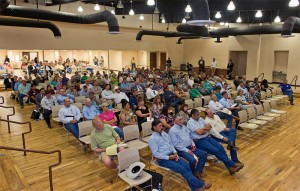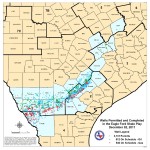A New Boom for Oil, but a Bust for State’s Rural Roads

Photo by Eddie Seal/Texas Tribune
Attendees filled the Alexander Convention Center on Tuesday evening for a Texas Department of Transportation hearing in Cotulla, TX on their controversial plan to convert some paved roads to gravel to save money on maintenance.
From the Texas Tribune:
COTULLA — At a convention center in this city 70 miles north of the U.S.-Mexico border, Dimmit County Judge Francisco Ponce said this week what many of the 200 people in the room were thinking.
Texas Department of Transportation officials explained why the agency needed to move forward with plans to convert some well-used paved roads around South Texas to gravel. For Ponce, the explanation exposed a long-standing problem in the agency’s perspective.
“TxDOT’s priorities are not in the rural counties,” he told the agency’s leadership, drawing cheers. “I don’t know how they can sit here and say it’s safer to gravel a road than it is to fix a road.”
Amid financing challenges, TxDOT announced seven weeks ago that it planned to convert 83 miles of farm-to-market road in the heart of the oil-drilling boom to gravel, most of that in the Eagle Ford Shale. Following a public outcry, the agency issued a 60-day moratorium on converting any roads. That has turned the end of October into a grim deadline for county officials hoping to find a way off the so-called gravel list. And as they consider options that include taking over the maintenance of the roads or soliciting donations from the energy sector, the officials say they are being punished for their region’s boom.
This week’s meeting was the highest-profile part of a recent effort by TxDOT officials to better explain their reasoning behind the plan. While the South Texas drilling boom has added billions of dollars to the state’s coffers, it has also badly damaged local infrastructure. Around the region, drivers must now navigate around and across yawning potholes, cracked asphalt and splintering shoulders. TxDOT has struggled to maintain its farm-to-market roads, which were not designed to handle the weight of thousands of heavy trucks that now regularly traverse rural communities like Cotulla to access new wells.
TxDOT Deputy Executive Director John Barton explained at the meeting that the agency lacks the funds to continue maintaining some of the roads as asphalt. Repaved roads that would typically last a decade are wearing away in three or four years. And the road conditions and drilling-related traffic are contributing to a spike in accidents.
“We have to maintain these roadways to an acceptable standard,” Barton said. “The difficult part is we have to consider all options of what we can do with the resources that we have.”
Converting the roads to gravel and lowering speed limits to 30 mph will make for a smoother and safer drive, Barton said. But many local residents predicted that the conversions would lead to more accidents, particularly if trucks ignore the reduced speed limits.
Several local officials suggested the plan was insulting given the state’s economic windfall from the Eagle Ford Shale.
“With all the money going into Austin, this is not right,” Atascosa County Judge Diana Bautista said.
While Live Oak County Judge Jim Huff agreed with TxDOT that converting some roads to gravel would be safer for drivers than leaving them in their current condition, he said the optics of the plan was breeding resentment.
“We’re sending money up there and we’re getting nothing back,” Huff said. “That’s what the public perceives.”
State lawmakers gave TxDOT a fraction of the budget it requested this year. The agency’s request included a one-time infusion of $1.6 billion solely to address damage on state roads related to energy sector development. The Legislature allocated $225 million toward that issue. In an August special session, lawmakers approved a measure to divert some of the oil and gas tax revenue currently earmarked for the Rainy Day Fund toward road construction and maintenance. The plan is expected to raise $1.2 billion annually if Texas voters in 2014 approve amending the state constitution to allow it.
In the meantime, the gravel plan is part of TxDOT’s effort to stretch its dollars and still address congestion issues around the state, including worsening congestion in urban areas. Agency officials said the roads that are converted to gravel would be repaved after the drilling-related traffic subsides.
“This is not a topic we take lightly,” TxDOT Executive Director Phil Wilson said.
La Salle County resident Leslie Kinsel said it was frustrating that state officials were not adjusting their priorities given the regional impact of the Eagle Ford Shale.
“The tables have completely turned,” Kinsel said. “We’re giving to the rest of the state. We’re driving the rest of the state. We need help right now.”

